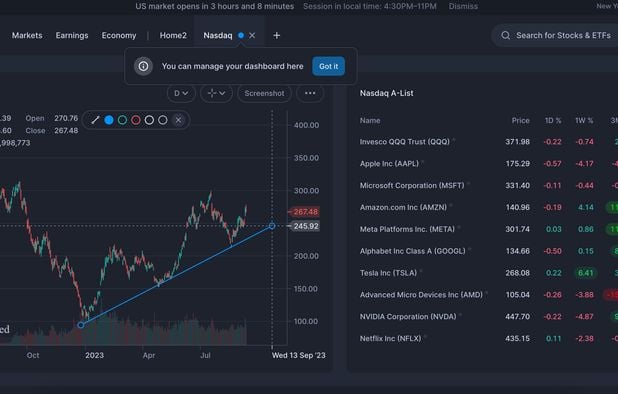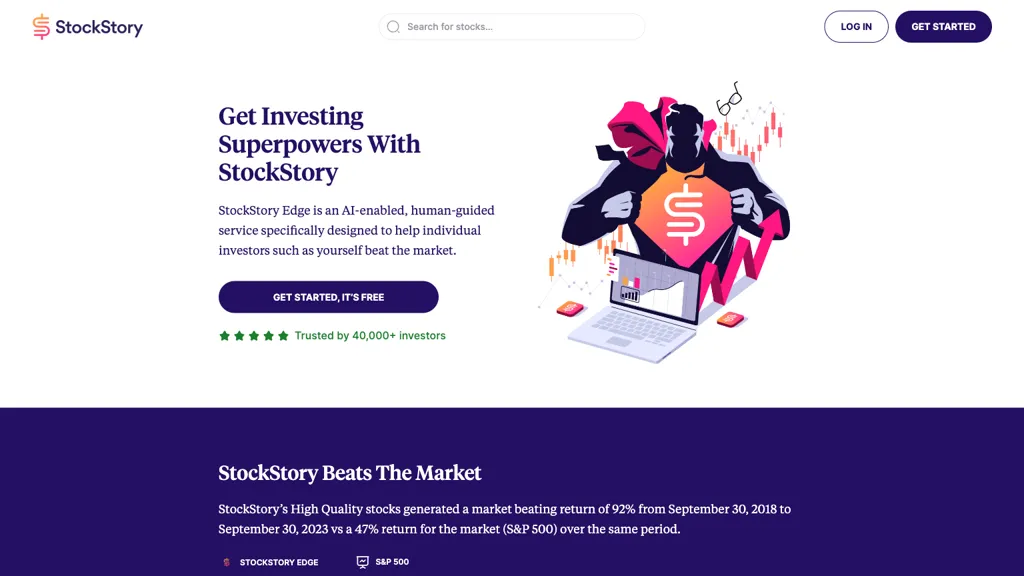20 Free Reasons For Choosing AI Stock Predictions Analysis Websites
20 Free Reasons For Choosing AI Stock Predictions Analysis Websites
Blog Article
Top 10 Tips To Assess The Accuracy And Performance Of Ai Stock Prediction/Analyzing Trading Platforms
You need to check the accuracy of AI trading platforms that forecast and analyze prices of stocks. This will assure you're using a reliable tool. Here are ten top suggestions for evaluating these platforms.
1. Backtesting Results
What to be looking for: Ensure the platform you choose to use allows you to conduct back-testing to determine the accuracy of its predictions based on the past data.
What is the significance of backtesting? Backtesting is a way to test an AI model through comparing the predictions with historical results.
Search for platforms that permit you to customize backtesting parameters, such as time periods and asset types.
2. Real-time Performance Monitoring
What to watch for: See how the platform performs under real time market conditions.
Why It Matters : Performance of platforms in real-time is superior than the backtesting of older versions.
Try a trial for free or demo account to observe and compare the accuracy of real-time forecasts to actual market movement.
3. Prediction Error Metrics
What to Look For: Evaluate metrics like Mean Absolute Error (MAE), the Root Mean Squared Error (RMSE), or R-squared, to measure the accuracy of your predictions.
What is the significance of these metrics give a measure of how accurate the predictions are to the actual results.
Tips: Platforms that publicly provide these metrics are typically more transparent and trustworthy.
4. Rate of Succeed and Win Rate
What to look out for: Check out the rate of winning on the platform which is the percent of predictions that are accurate. Also check its success ratio (the return on trades based on predicted outcomes).
Why it matters The high success rate and win percentages indicate greater accuracy in predicting and greater chance of generating profits.
Beware of websites that claim to have a high win rate (e.g. 90%) %+),) since the system cannot ensure 100% success.
5. Benchmarking against Market Indices
What to look out for: Compare platform predictions and results to major indexes (e.g. S&P 500, NASDAQ).
Why It Matters This is crucial because it allows you to determine whether this platform outperforms (or outperforms) the overall market.
TIP: Don't only seek out short-term gains but also consistent performance over a longer period.
6. Consistency in Market Conditions
What to be looking for What is the performance of the platform when there are different market conditions.
What is the significance of it A solid platform can perform well across all markets, not just those that are in good conditions.
Tip Test the platform's forecasts in volatile times and during market declines.
7. Transparency in Methodology
What to Look For How to recognize AI algorithms and models (e.g. neural nets or reinforcement learning).
Why it is Important Transparency in methodology lets you determine the validity and scientific rigor of the system.
Avoid platforms using "black box models" that don't clarify how they generate predictions.
8. Tests by independent experts and User Reviews
What to look out for: Read reviews from users and independent testing and third-party evaluations.
What's important: Independent reviews and testing offer unbiased information about the reliability and effectiveness of the platform.
TIP: Go to forums like Reddit, copyright, or financial blogs for reviews of user experiences.
9. Risk-Adjusted Returns
What to Look Out For You can measure the performance of your platform by using a risk-adjusted metric like Sharpe Ratio or Sortino Ratio.
What is important : These metrics are based on the amount of risk is taken to produce returns. This provides a more complete image of performance.
Sharpe Ratios that are higher than 1 suggest higher returns. risk-adjusted.
10. Long-Term Track Record
What to Look for: Evaluate the platform's performance over time (e.g. 3 to 5 years).
The reason it's important The long-term results are a far more reliable indicator of reliability as in comparison to results from short-term.
TIP: Avoid platforms that focus on the short-term results or only cherry-picked ones.
Bonus Tip: Test with an account that is a demo
Utilize a demo account, or a free trial to test the predictions of the platform in real-time without risking real money. It allows you to see the accuracy of predictions as well as their performance.
These tips will help you evaluate the reliability and performance AI stock predicting platforms. This will allow you to pick one that best suits your trading needs and your risk tolerance. Never forget that no platform is the perfect one. Combining AI insights with your own research is the most effective way to go. Have a look at the most popular linked here about ai for investment for website recommendations including ai trading, market ai, ai investing platform, using ai to trade stocks, ai stock trading, best ai for trading, chart ai trading assistant, best ai trading software, ai for investment, chatgpt copyright and more.
Top 10 Tips To Assess The Regulatory Conformity Of Ai Stock Predicting/Analyzing Platforms
When looking at AI trading platforms, regulatory compliance is critical. Compliance assists in ensuring that the platform is operating within legal frameworks and protecting the privacy of users. These are the top 10 suggestions for assessing compliance with regulatory requirements.
1. Check the Licensing and Registration
Regulatory bodies : Verify that the platform is licensed and registered by the appropriate financial regulatory authority (e.g. SEC, FCA, ASIC, etc.) in your country.
Broker partnership: If the platform incorporates brokers, ensure that the brokers are legally licensed and regulated.
Public records: Visit the website of the regulator to find out whether the platform is licensed or if it's ever violated the law.
2. Measure Data Privacy Compliance
GDPR - If your website operates within the EU and/or provides services to users in the EU make sure it complies with GDPR.
CCPA for Californians be sure to check the compliance of California Consumer Privacy Act.
Data handling policies: Read the policy of the platform on data privacy to make sure that it clarifies exactly the way that user data is stored, used and shared.
3. Examine the Anti-Money Laundering(AML) Measures
AML policies: Ensure the platform is equipped with strong AML policies that are in place to prevent and detect cash laundering.
KYC Procedures: Verify whether there are procedures on the platform for confirming the identity of users.
Transaction monitoring You can find out if the platform monitors all transactions for suspicious activities and notifies the authorities.
4. Make sure that you are in compliance of your business with Trading Regulations
Market manipulation: Ensure the platform is equipped with measures to prevent market manipulation, such as spoofing or wash trading.
Order types: Confirm that the platform meets the regulations for order types (e.g., no unlawful stop-loss hunting).
Best execution: Check if the platform follows the highest standards of execution, and ensures that transactions are executed at the highest price available.
5. Assessment of Cybersecurity's compliance
Data encryption: Ensure that the platform protects user data both while it is in transit as well as when it is in rest with encryption.
Incident response - Verify the system's plans to react in the event of cyberattacks or data breaches.
Certifications - See whether your platform holds any cybersecurity certifications.
6. Review Transparency and disclosure
Fee disclosure - Make sure the fees are fully disclosed, even hidden or additional charges.
Risk disclosure: Make sure the platform provides clear information on risk. This is crucial for trading strategies that have high leverage or risk.
Performance reporting: Determine whether the AI platform's models are transparently and properly reported.
7. Check for the conformity to International Regulations
Cross-border Trading: If your trading involves international markets, you should ensure that the platform meets all requirements for regulatory compliance in every region.
Tax reporting: Check whether the platform has tools or reports that can help users comply with tax laws (e.g., FIFO rules in the U.S.).
Respect for international sanctions: Make sure your platform is in strict compliance with these and doesn't allow trading between countries or entities that are banned.
8. Review Record-Keeping, Audit Trails
Transaction records: Make sure the platform records detailed details of every transaction for the purposes of auditing and regulation.
Logs of activity for users (logs): Check to check if the platform records the activities of users, such as transactions and logins. Also, make sure that the settings for your account have been changed.
Audit readiness: Check if the platform can provide necessary documentation and logs in the case of a regulatory audit.
9. Check for compliance with AI-Specific Regulations
Algorithmic trading regulations: If a platform supports algorithmic trading, make sure it's in compliance with regulations such as MiFID II in Europe or Reg SCI in the U.S.
Fairness and impartiality: Verify whether the platform's AI models are monitored and tempered to prevent bias.
Explainability. Some regulations may require that the platform provide an explanation of AI-driven predictions and choices.
10. Review User Comments as well as Regulatory Historical History
User reviews: Use user feedback to determine the platform's compliance with regulations.
Regulatory history: Verify whether there have been any violations to the rules of regulation that were committed, as well as fines and penalties.
Third-party checks: Ensure the compliance of the platform with the law by checking if it undergoes periodic audits from third party.
Bonus Tips
Legal consultation: Consult an expert on the subject to check whether your website is in compliance with the regulations.
Trial period: Use a free trial or demo to assess the platform's compliance capabilities and the documentation.
Support for customers: Make sure the platform has support available to answer questions or concerns that concern compliance.
With these guidelines you can identify the level of compliance with regulations within AI stock trading platforms. This will enable you to select a platform that is operating within the legal framework that protects your interest. Compliance is crucial because it not only lowers legal risks, it also increases trust and confidence in the platform. Have a look at the top rated do you agree on ai in stock market for more info including ai software stocks, how to use ai for copyright trading, stock predictor, ai stock predictions, ai stock investing, can ai predict stock market, how to use ai for copyright trading, ai trading tool, ai share trading, ai options trading and more.